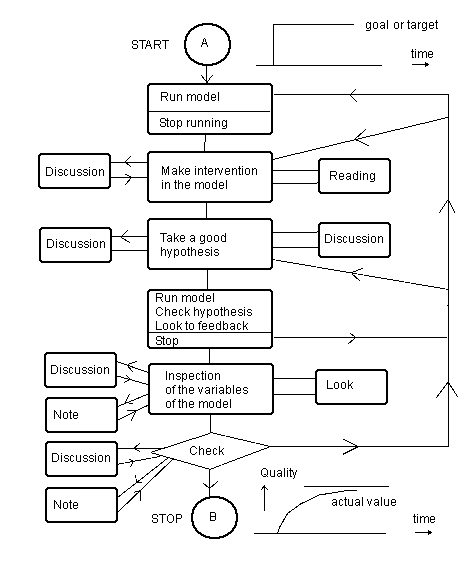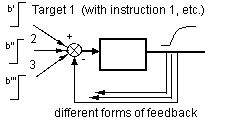Keywords
learning, models, modelling,
model of learning, learning model,
instruction, instruction sources, means of instruction,
study-ability, motivation, incentives,
half-life-time, feedback systems,
quality control
a learning model
is not
a model of learning
Learning models

One of the five learning models: qualitative.

One of the five learning models: quantitative.
learning model 1:

Learning by making exercises
learning model 2:

Learning by solving cases (learning by solving problems)
learning model 3:

Learning by coaching (coached discovery learning)
learning model 4:

Learning by working as a scientific worker
learning model 5:

Learning in an learning environment with intelligent feedback
Learning is doing

Parallel instruction: Input and output process for a learning process that should be kept going. On the input side the different kinds of instruction (manuals, pictures, teachers, etc.) and on the output side of a 'learning process' the different kinds of feedback (graphical, texts, etc.).
Learning as a feedback system: there is a starting value (A); a target (B); every minute, hour of day you compare the actual value (OUT) of the knowledge with the target.
At the top: the 'target' that one has set at the beginning; middle: the difference between the desired value and the actual - measured - value. Below: the 'quality' of the product.
Instruction as input for the learning process: the learning curve. At the top: the 'target'. Below: the accumulation of knowledge.
A large (and differentiated) supply of (learning tools). It has been indicated here that a student chooses the instruction tools or knowledge sources himself. There is an enormous supply. Resistance against the one (e.g. against study-ability) is higher or lower than against the other instruction (or learning tool).
Schematic idea about 'parallelism' and the 'parallel instruction theory' of Min: on the input side of a learning environment a lot of instruction types and/or formats are possible and on the output site did a lot of model-driven feedback forms are possible. And every thing in common and/or parallel (Min, 1994) The heart of the analogon - the transfer function from input to output - simulated on a PC. The transfer function of this model is of the du/dt=1/RC (E-u) type. You should realise that e=E-u. Here e=IN-OUT. The integrator will go on integrating until e=0. At that moment u=E or OUT=IN. So this model could be a model for knowledge acquisition.
A slightly expanded model for acquisition of knowledge. Program 'LEARNING', version 2.0x. You see in this simulation program in which the model for learning has been included that there are a number of targets which the student can set himself. Then on will achieve a certain level of knowledge. You start at level 5 and chooses level (or target) 6,7,8,9, or 10. In this example one chose level 5 at the moment in time t=0 and on t=0.1 the target level was 9. (The begin level of the student was 3.) You can see that the student reaches the levels after acertain time.
Enschede, febr. 19, 2002
Model of learning (1)

Target and the actual value


Model of learning (2)

Model of learning (3)

Model of learning (4)


Simulation
The interactive simulation model. Left for experimental work; right for references.
Here you can start - by clicking - the interactive model of learning of Min (febr. 2000) as described in the text.
Case 1: If you change the 'target' ('IN') from '3' to '6' you see the outcome depends on 'studeerbaarheid' ('study-ablity') (R1) and 'motivation' (R2). Stop if the target is reached. Than you have to decrease R1 and/or R2 and than put the target to 9 the 50%-time cost twice as much than before (case 2). You see that 'duration of learning' (the 'leaning traject') is just the time until the difference between target and output (difference) is about zero. We call it the 100%-time. (The 50%-time - or half-life-time - is the time - in weeks - the target is reach at 50 procent.) Alpha says to what extent the slope is. In black you see a reference: the output with the normal parameter values.